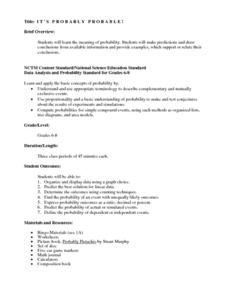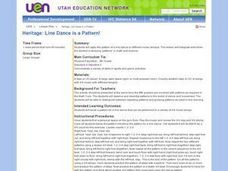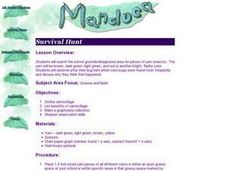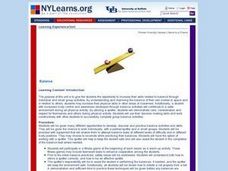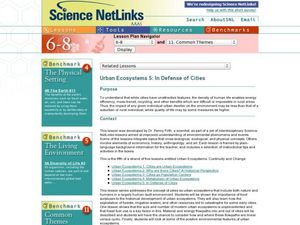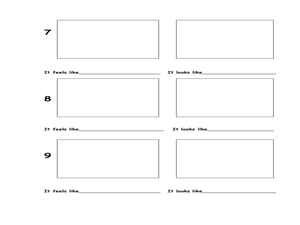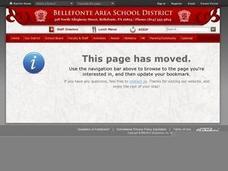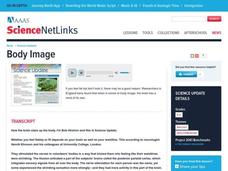Adrian College
The Universe
Young scientists create a simulation of Hubble's law. Introducing the Big Bang Theory using balloons and a simple lab worksheet, scholars complete a data table and perform analysis.
NASA
MASS, MASS – Who Has the MASS? Analyzing Tiny Samples
What is it worth to you? A hands-on lesson asks groups to collect weights of different combinations of coins and calculate weighted averages. They use the analysis to understand the concept of an isotope to finish the third lesson in a...
Glynn County School System
Earth's Magnetic Field and the Moon
The surface of the moon has an amazing tale to tell. Learn about the moon's story with a PowerPoint presentation that describes the unique features of the moon's surface as well as explains its movement in relation to Earth.
Curated OER
Macromolecule Lab
During a macromolecule lab, young chemists perform multiple tests, including iodine starch tests, to determine if eight mystery foods contain lipids, sugars, or starches.
Mascil Project
Circular Pave-Stones Backyard
Pack the lesson into your plans. Young mathematicians learn about packing and optimization with the context of circular paving stones. They use coins to model the paving stones, and then apply knowledge of circles and polygons to...
National Security Agency
It's Probably Probable
Learners make predictions and draw conclusions from given information as they learn the meaning of probability in this vocabulary-rich, integrated activity that presents a variety of teaching strategies to motivate and reach...
Curated OER
Heritage: Line Dance is a Pattern!
Line dancing is the repeating of a pattern of steps, done to music. Teach youngsters how to line dance and they won't feel so awkward when they grow up. Let them experiment with creating their own patterns and teaching their classmates....
Curated OER
Survival Hunt
Students search for yarn representing insects on school grounds. They discuss which colors where found more frequently and why after the experiment. They use their math skills to determine percentages.
Curated OER
Balance Activities
Students, through group and individual activities, study and experiment with the concept of balance. They attempt balancing tasks at different levels of difficulty and in different body positions. They work to improve their balance.
Curated OER
Mars 500: Would You Go?
In this Mars worksheet, students read a 7-paragraph article and respond to 8 graphic organizer, matching, and short answer questions. Vocabulary words and definitions are included.
Curated OER
Chart the Stars
Seventh graders find constellation distances and plot the stars. In this star lesson, 7th graders plot the star points for Canis Major. Students use graphing calculators to graph the constellation. Students choose another constellation...
Curated OER
Water and Ice
Young scholars investigate what happens to solids and liquids when they change from one form to another. The amount od space taken by frozen water begins the discussion and students are led to formulate their own hypothesis to research.
Curated OER
Green Leaves
Third graders, after having conducted one experiment three times, record their observations results in a chart. They predict what hidden colors they believe that a leaf holds. Students record their predictions in their science note books...
Curated OER
Altering Climate in the Classroom
Students experiment with moderating temperature extremes in the classroom. They experiment with ways to vent and block air.
Curated OER
Will The Ice Melt and Overflow?
Students observe what happens when ice in a glass of water starts to melt. In this ice lesson plan, students see that the ice does not make the water overflow, it simply occupies the space it did in frozen form.
Curated OER
Speed Trap
Students conceptually explore motion graphing by producing motion at different speeds and directions. They experience the lab and then graph the motion of the truck at various speeds and directions. The procedures of velocity are...
Curated OER
Exploring Marine Objects
Students identify the sources of water on Earth. In this life science lesson, students list the different plants and animals that live in the ocean. They explore marine objects in the lab and draw them.
Curated OER
Antacid Tablet Race
Young scholars compare the reaction rates of effervescent antacid tablets under different conditions. They investigate methods of increasing the power of rocket fuels by manipulating surface area and temperature.
Curated OER
The Earth Around Us: Air, Water & Soil
Students build an air cannon and study air mass. In this air cannon lesson, students create and shoot an air cannon and observe what happens. Students answer critical thinking questions about air mass and air cannons.
Curated OER
Project X-35
Students demonstrate rocketry principles through a cooperative, problem solving simulation. They work in teams to simulate the development of a commercial proposal to design, build, and launch a rocket.
Curated OER
Greenhouse Effect: A Computer Simulation
Students complete an online simulation of the greenhouse effect. In this lesson on the greenhouse effect, students use a website, similar to a webquest, to simulate and answer questions on how the greenhouse effect works. This lesson is...
Curated OER
Bottle Rocket Launcher
Students construct a bottle rocket launcher for use with the Bottle Rocket and Project X-35 activities. They construct a bottle launcher from "off-the-shelf" hardware and wood using simple tools.
Curated OER
Paper Towel Testing
Students discuss whether there are variations in absorbency and wet strength amount different brands of paper towels. They compare advertising claims and personal preferences and perform tests to reach a conclusion of which brand is the...
Curated OER
Body Image
Students read and answer questions on neural processing and the Pinocchio Illusion. They relate and discuss these topics in conjunction with body-image disorders such as anorexia and bulimia . This lesson include video extension activities.





